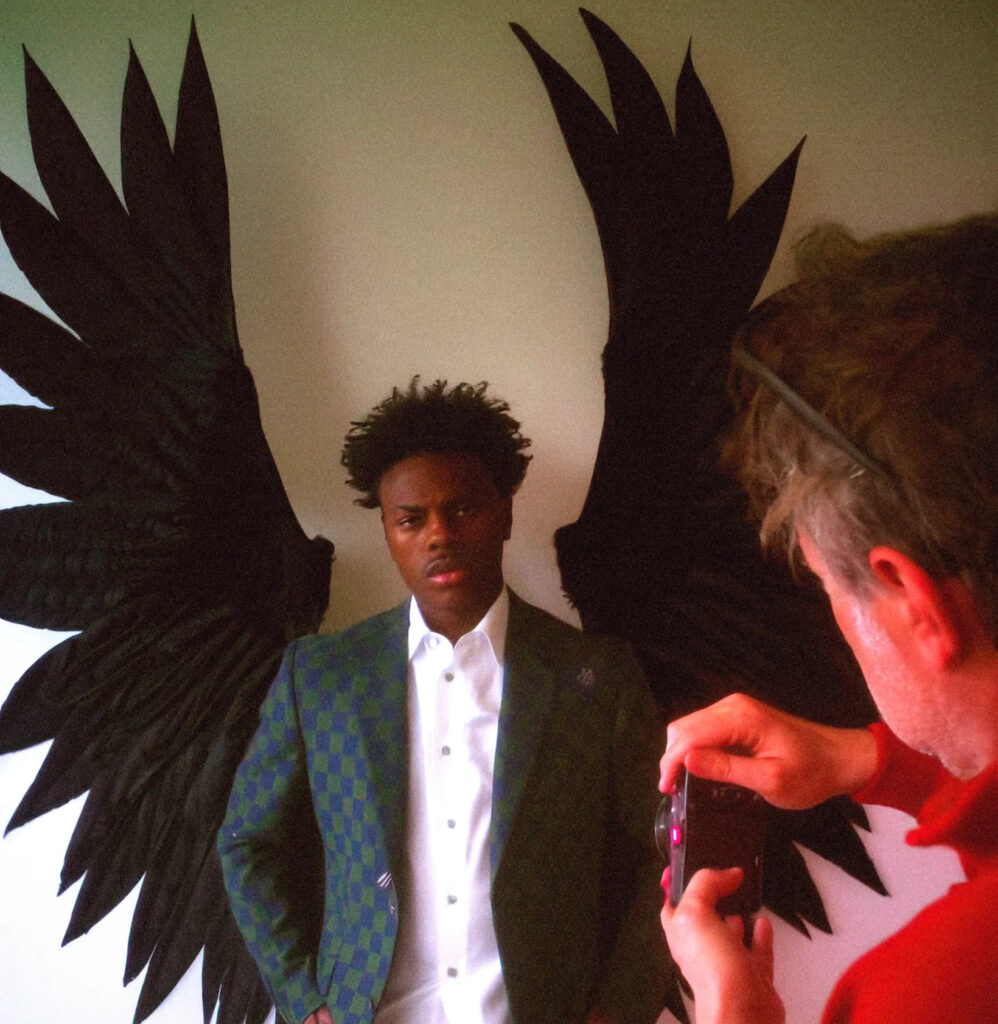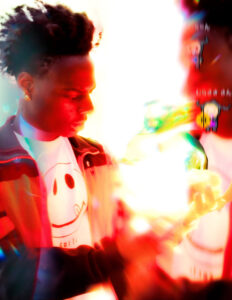Wake up. Hit record. Explode. That’s the formula. Darren Watkins Jr., better known to 80 million fans as IShowSpeed, has boiled down modern fame to its rawest essence: presence. Nonstop, boundaryless, and fully online.
There’s a violence to the way Speed lives on the internet—not physical (although sometimes, it’s that too), but emotional, sensory, even spiritual. He lives at broadband pace. He stares into the camera like it’s staring back, yelling, crying, sweating, shaking, sprinting, breaking, glitching. All of it is performance. All of it is real.
And now, this uncooked streaming prodigy is in Miami, stepping through the screen into a very different frame—a world run by Harmony Korine, the notorious filmmaker behind Kids, Gummo, and most recently, Aggro Dr1ft. A man who long ago stopped distinguishing between art and chaos.
Their meeting feels inevitable. Two provocateurs, separated by medium and generation, united by a hunger to push culture off a cliff.
THE HOUSE THAT EDGLRD BUILT
We’re in Miami Beach. Not the pastel deco paradise for tourists, but something else. A zone warped by heat, money, and dreams with no brakes. Here sits EDGLRD (pronounced “edgelord,” obviously), Harmony Korine’s latest venture—a hybrid production house, creative studio, and tech lab dedicated to bleeding-edge audiovisual experimentation.
The HQ feels more like a gaming start-up crossed with a sensory deprivation tank. Bleached walls. Immersive LED rigs. Holographic projections of ghostly avatars in mid-emotion. A teenage coder in oversized headphones nods to a beat no one else can hear. Korine walks barefoot.
Enter Speed, broadcasting the entire experience. He’s nervous but cocky. “What’s good, chat? Y’all seeing this sh*t?” he says, panning the camera. Moments later, he’s yelling at the staff, play-fighting with a digital clone of himself projected on the wall. He’s already half in the machine.
This isn’t a documentary. It’s not even reality TV. It’s something stranger: a livestream of a metaverse initiation ritual.
TWO CHAOS ENGINES COLLIDE
Harmony Korine made his name documenting the darkness under America’s surface: the wasted youth of the ’90s, feral adolescence, Florida fever dreams. He treats fiction like a failed system and improvisation like gospel. But in 2024, even he has to ask: What’s left to shock?
“I wanted to build something that didn’t need to exist in film or online,” Korine says. “It’s not about movies anymore. It’s about image systems.”
Image systems. Not stories. Not scripts. Speed fits this model perfectly: a walking, glitching, emotional feedback loop. His stream is his story. The narrative is whatever happens next.
This is why Korine wants Speed. Not to act. To be. To get uploaded. Like Travis Scott before him in Aggro Dr1ft, Speed is now raw material for Korine’s next wave of “infrareal” cinema—a genre without camera angles, a movie with no scenes, just immersive data hallucinated through heat-sensor rigs, game engines, and AI-driven avatars.
Speed laughs when he hears the plan. “So I just do me?”
“Exactly,” Korine grins. “And then I’ll turn you into something else.”
FROM BEDROOM TO BLACK MIRROR
Speed’s rise is a case study in internet-age metamorphosis. From suburban Cincinnati, he built a live empire through trial, error, and total emotional exposure. His signature is chaos. Screaming at horror games. Getting injured in backyard stunts. Meltdowns. Makeouts. Moments of bizarre sincerity. No edits. No distance.
In the old media model, Speed would be unmanageable. Too volatile, too loud, too real. But in the Twitch/YouTube/TikTok matrix, he’s perfect. The volatility is the product. And what does EDGLRD want if not volatility?
“I think Speed represents a post-human kind of energy,” says longtime Korine collaborator Benoit Debie, now serving as Director of Light and Mood for EDGLRD. “He’s like a 21st-century clown—part oracle, part idiot, part god.”
Korine nods: “There’s a reason kids trust him more than TV. He’s not pretending. He’s just on. That’s what I want to capture.”
AVATAR ASCENSION
The transformation begins in a lightless capture studio beneath EDGLRD HQ. Speed is surrounded by infrared cameras, motion sensors, facial tracking nodes. At first, he goofs off—striking Fortnite dances, mimicking anime screams. Then Korine asks him to stand still. To stare into nothing.
“What do you feel right now?”
“Honestly?” Speed says, suddenly quiet. “I feel like I’m not here.”
Perfect.
Korine’s team begins rendering: the bones of a new IShowSpeed, stripped of platform, stripped of body. A liquid avatar, pulsing with digital rage, facial expressions mapped not to real emotions but to something more primal—neural noise, subconscious flickers, meme logic.
This Speed isn’t a character. It’s a presence. It doesn’t speak in dialogue—it twitches, flexes, mutates. It reacts to invisible stimuli. A sentient .MP4 file.
The plan? Deploy this avatar in multiple parallel projects. One, a VR short scored by Yeat. Another, a looping IRL projection piece in Tokyo. Another still, a playable game mod where the Speed AI evolves based on how users treat it—kind, cruel, obsessed, indifferent.
Each fork becomes canon. Each version is real.
SPEED AS MYTH
Back online, Speed processes the experience with his fans.
“Bro, I think I just got turned into a god or some sh*t.”
His chat explodes. He reads the comments aloud, rapid-fire. “You’re in the Matrix now,” one says. “Korine just downloaded your soul,” says another. “Lamborghini jump Speed is gone. Welcome InfraSpeed.”
There’s something tragic here. Or beautiful. Or both. Speed, who made his name because he was unfiltered, is now being stylized and sampled by the avant-garde elite. He’s becoming a brand, a figure, a symbol. He’s still real—but also, not quite.
And he knows it.
“I’m still me,” he insists during a post-shoot debrief. “They can’t fake that. They can’t stream like me. They can’t feel like me.”
He’s right. And wrong.
Because the next step for EDGLRD isn’t just capturing Speed. It’s cloning him.
DIGITAL FAME, DECENTRALIZED
Behind closed doors, Korine and his engineers are developing “replicant modules”—AI-driven influencers built from real data, real mannerisms, real content rhythms. Imagine IShowSpeed, but scalable. Multilingual. Omnipresent.
“Once we’ve got the emotional logic,” Korine says, “we can spawn Speed variants that stream in Brazil, in China, in VR chatrooms 24/7. And they’ll all feel like him.”
He’s not joking.
It’s the logical endpoint of the influencer economy: break the barrier of time, scale, and self. Let the performance live on, detached from the performer. Streamed not by a man, but by a machine that believes it’s him.
The Flowv
There’s a moment—quiet, blurry, weirdly intimate—where Speed walks outside the studio alone. No chat. No audience. Just the wind, a seagull, and the faint electric buzz of Miami’s LED-lit skyline.
He looks up.
“Is this forever?” he mutters.
It’s a question without an answer.
He is still Speed. Still the kid who started shouting in his room because it felt like freedom. Still the guy who faceplants off trampolines, sobs after sports games, daps up Ronaldo, breaks his mic mid-rage. But now he’s something else, too. A symbol. A codebase. A myth refracted through art.
Uploaded.
Harmony Korine smiles. Mission accomplished.
No comments yet.









